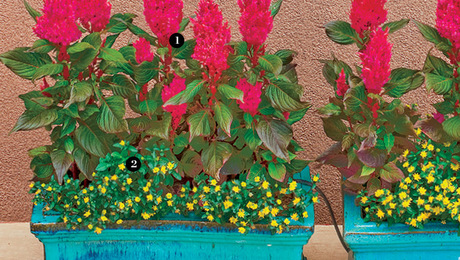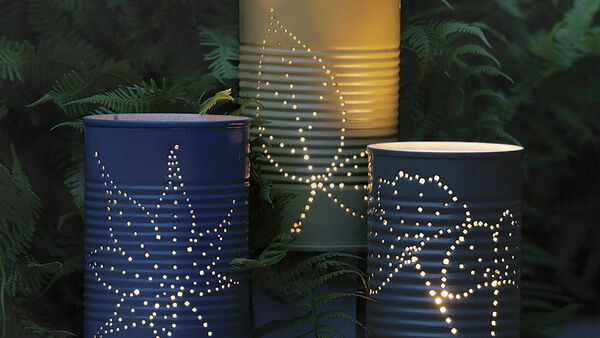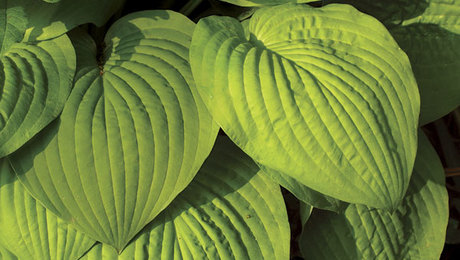
Photo/Illustration: Virginia Small
Each fall, after I put my garden to bed for the winter, I take a break in Mexico, where intense, vivid colors electrify almost everything. Seeing houses painted orange, turquoise, and fuchsia or viewing lush, green jungles shimmering under a cobalt sky inspires me to think about color in new ways. Several years ago, while sitting in a Technicolor café where every chair and table was painted a different, eye-popping hue, I realized that this playful use of color could work well in my garden. I’m always striving for bold, dramatic colors in my plantings, and the use of paint, I decided, could elevate my designs to a new level. With a few strokes of a brush, I could add a splash of color, create an instant centerpiece, or round out the palette anywhere in my garden. I knew that using color from a can would provide long-lasting effects, adding zip to the garden all year long.
I started on this path gradually, initially placing colorful containers and watering cans within my plantings. Then I upped the ante by taking a brush or spray can to some of my garden furniture. Emboldened by the results, I started painting larger areas: trellises, fences, tuteurs, and even parts of my house. And I’m glad I did. For a minimal amount of expense and effort, the extra vitality of all that color breathes life into my garden during winter’s gloom, adds oomph in spring, and enhances summer’s beauty. In fall, it makes a wonderful foil for changing foliage.

The first thing I had to do was to get past my fear of tackling a painting project. After all, the whole notion is a bit of a gamble. What if the results proved too garish? It helped when I reminded myself that any disaster could be repaired by simply repainting it a different color.
The next challenge was selecting colors. I gave myself a single ground rule: avoid anything that might clash with our Colonial-style house. Both the trim and clapboards are gray, which left my options fairly open. If I had a more colorful home—a mauve Victorian, for example—I might be careful about using, say, orange paint for a garden structure. Unconventional color contrasts are fine if that’s your thing, but I decided to be a little more cautious. I wanted to take my colors to the top but not over it.
For inspiration in choosing colors, I like to mull over the samples in a paint store. I look for hues that evoke a positive response. I’m usually drawn to blues, some pinks, a range of chartreusey greens, and a handful of yellows. I steer away from whites. Though white goes with every other color, it does so immodestly, forever calling attention to itself. If I’m going for color, I want color.
Three ways to use color from a can
Use primary colors for focal points

Any object painted a primary color— a true red, blue, or yellow—can be used to add a valuable focal point. These attention-getting hues are visual lures that draw attention wherever they’re placed. For example, a painted blue gate stands out, even when winter makes a garden look stark.
For a garden with perennials and shrubs, I painted a tall tuteur a deep, true blue. This contrasting color rounds out the palette of the reddish-leaved plants and yellow flowers that dominate the area and the lush greens of the foliage. That was enough to show me that a true blue—that most sought-after color in flower gardens—is easily added with paint, and it goes with nearly everything. Even a modest accent, such as a brightly painted watering can or a cobalt blue container, makes a big contribution to any garden vignette.
Use muted colors for a subdued effect



For a more restrained look, consider grays, greens, and muted earthy colors. Just as they do in nature, these colors act to camouflage and blend in with the surroundings. An outbuilding or shed can be rendered nearly invisible just by giving it a coat of gray or gray-green paint.. The same holds true for a fence or trellis.
Muted colors can also be used to make an inviting haven. I combined two greens to reinforce a soothing, cool-feeling oasis on a terrace beneath a pergola next to my house. I painted the wrought-iron dining set a soft, mossy green and the house trim a yellow-tinged green. A blue-gray bench nestled within a nook of foliage plants offers a spot for contemplation.
Harmonize colors to create accents



There’s a place for colorful paint even in a garden that emphasizes a single hue or a few harmonious colors. To heighten a monochromatic effect, paint furniture or hardscape the same color. For example, in a garden of yellows—with colors ranging from chartreuse to orange-kissed hues—the best bet is paint that’s a pure yellow, something right in the middle of all those shades. That way, it will serve as a visual anchor to pull everything together. You can also use paint to create vignettes of color harmony. For an ephemeral effect, you might paint a chair orange to match the display of a sweep of Exbury azaleas while they’re in bloom. Or paint a table hot pink as an accent for a garden with shades of pink blooms and foliage.
Audition samples outdoors
Back home, I compare my samples against the house and in various garden settings. This is an essential step since colors that may seem too dark under indoor lighting might actually look lighter in bright sunlight. Experimenting has been the key to my success with paint. I always buy a test quart of a new color, rather than committing to an entire gallon. If it works, I buy more. If it doesn’t, I try another color. And I always use water-based latex paint since cleanup is easy and it’s a breeze to repaint something another color. For metal furniture, paint in a spray can is ideal. It limits your selection—not every color is available— but for ease of use it can’t be beat. There are no brushes to buy or clean, and painting is quick. I’ve spray-painted a table and four chairs in just over an hour.
Focus on a single spot
Finally, I realized that using bold color may not be an effect to repeat throughout my entire garden. A little bit goes a long way. I think vivid paint colors are best used in small oases within a garden, where they can create a whole kaboom of color. I’ve made plenty of impact with just two chairs and a table—it’s amazing what painting them a deep blue and an electric chartreuse can do. I’ve got this seating area against a backdrop of colorful foliage, so it really sizzles. My big bang provides a pleasing effect, even in winter when all the blooms are gone.
Perhaps the best thing about using painted elements in my garden is that it’s an evolving aesthetic process. Just as with my combinations of flowering plants, my compositions that rely on painted objects improve each year, thanks to my ongoing efforts to tweak them. Now that I’m thinking more about color, I often find new sources of inspiration for using paint in creative ways. Every year, I paint a fence, a trellis, or a little more furniture, and those new colors continually enrich my garden in ways that go far beyond the flowers.





















Comments
Log in or create an account to post a comment.
Sign up Log in